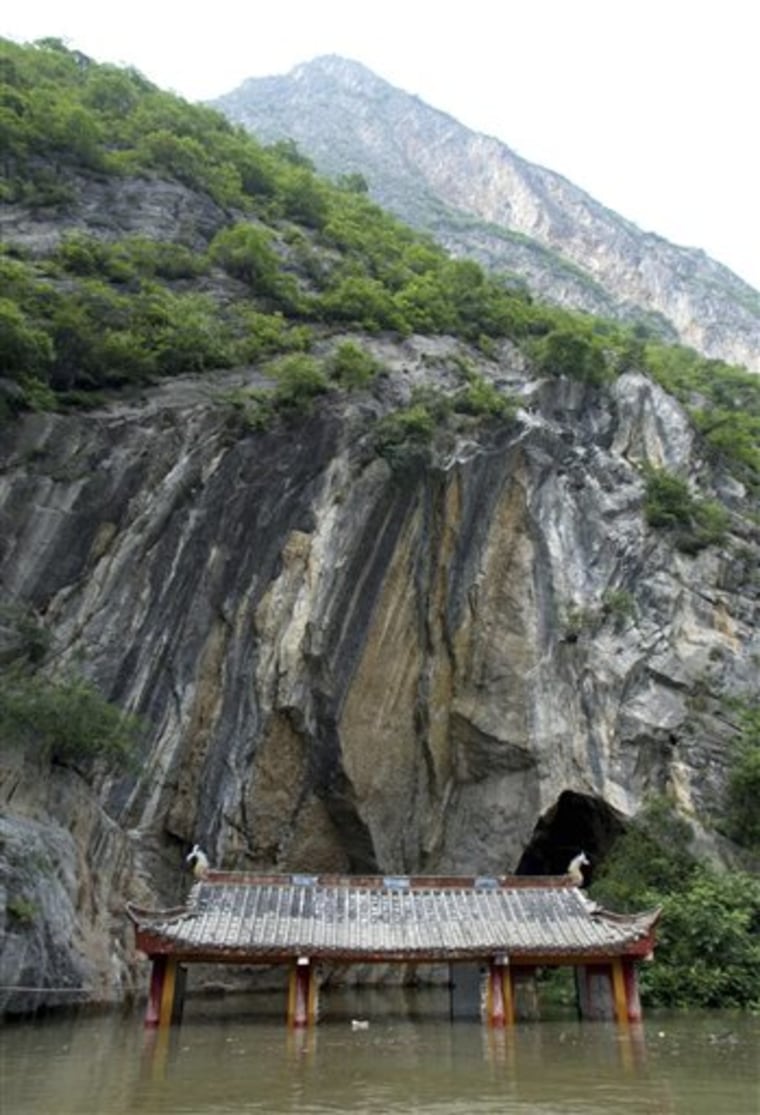Plans to raise the water level behind China's massive Three Gorges dam to full capacity this month — which would mark the symbolic culmination of the decades-old project — have stalled amid a worsening drought and reports of increased landslide risks.
China has for years promoted the world's largest hydroelectric project as the best way to end centuries of floods along the basin of the Yangtze River and to provide energy to fuel the country's economic boom.
Along the way officials have often steamrolled over complaints about the enormous environmental impact of the mammoth $23 billion, 410-mile-long (660-kilometer-long) reservoir that has displaced more than 1.4 million people.
Dam authorities had been increasing water storage since Sept. 15, with the goal of reaching the maximum height of 574 feet (175 meters) by early November, when the dam would be fully capable of generating the maximum amount of power. But on Nov. 2 the water reached 561 feet (171 meters) and then abruptly stopped — rising no higher.
Deepening drought
The explanation given by dam officials is that too little water is flowing from the upper reaches of the Yangtze — 34 percent less than last year — coupled with a deepening drought in the downstream provinces of Hunan and Jiangxi.
A spokesman for the State Council committee overseeing the Three Gorges project acknowledged last week it would be "difficult" to raise the water level to its peak height.
"Under the current conditions, less water is coming from the upper reaches and more water is needed to be released to the lower reaches to ease the drought situation. So it's difficult to reach that level," he said, declining to be named because he wasn't authorized to speak on the subject. He gave no timetable for when the maximum height would be reached.
The tacit postponement has also come amid urgent reports warning of heightened landslide risks.
Last week, investigative magazine Caijing revealed a report issued by a Chongqing political consultative body that warned that the risks of geological disasters, such as landslides, would increase as the water rose to its apex. It also said that the rising water levels were also reviving old landslide fissures as the soil around the dam became more saturated and unsettled.
Possible landslide spots
The Caijing report also cited a pre-flood inspection this year by officials in the Wanzhou district of Chongqing, the megacity near the reservoir, that identified nearly 700 areas vulnerable to geological damage, 587 of them possible landslide spots.
Yang Yong, a Sichuan-based geologist who has followed the dam project closely, said he believes the renewed threat of geological disasters may have been serious enough to delay the final phase.
"Dealing with drought is a quite obvious reason, but I suspect that the potential geological threat is also a factor in stopping the water from rising," he said. "I think with the rise of the water level, the geological movement around the area is becoming more and more frequent. The government was quite aware of the problem."
Warnings had been voiced in the past about increased geological risks as water poured into formerly dry slopes, causing serious erosion and seismic instability.
Problems with erosion
As the water level rises, it seeps into the soil along the reservoir, saturating and loosening the bank slopes. The fear is that it weakens the ground soil to the extent that erosion and collapse could occur.
The Three Gorges spokesman denied that geological risks played a factor in the delay, saying landslides are "no big problem." But the continuing drought that has crippled large swaths of southern and central China since August has brought pressure on dam officials to release more water downstream, he said.
A more immediate reminder of the geological danger came last month. On the night of Oct 16., officials in the township of Quchi near Chongqing issued an emergency notice after a new fissure was discovered in an old landslide area on slopes above the town, confirmed an official there surnamed Yang. The hairline crack was reportedly 1,300 feet long (400 meters).
Experts had discovered cracks appearing in the walls of local homes, and dozens of residents were immediately evacuated from the area that day. The local official said the town had evacuated residents six or seven years ago from the same area.
Zhang Hua, a professor at the Research Center for Geo-hazard Prevention & Mitigation Technology at China's Three Gorges University who investigated geological hazards in the area in August, said he believes mitigation measures in place now provide adequate protection for villagers who live near the dam.
But he acknowledged that "with the rise of the water, I can't rule out potential dangers which are hard to predict."
"The main threat is the change of the stress condition in the soil. Soils used to be dry before the water rises and are relatively stable, but the water will bring erosion and make the stress condition very unstable," he said.
Even in areas where preventive measures have already been applied, "new geo-hazards may still happen with the change of water level, because you're dealing with soft soil instead of concrete."
